
HOME
INTRO
SYMBOLS
ALMANAC
ECONOMY
GEOGRAPHY
STATE MAPS
PEOPLE
FORUM
NEWS
COOL SCHOOLS
STATE QUIZ
STATE LINKS
BOOK STORE
MARKETPLACE
GUESTBOOK
CONTACT US


The State of Michigan
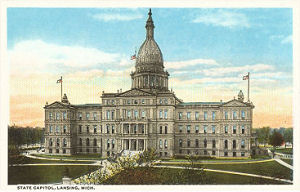
Michigan Capitol, Lansing
Welcome to Michigan, the Great Lake state. Michigan is quite unique among the states in that it is divided into two distint geographic sections, the Upper peninsula, and the Lower peninsula. Lake Michigan lies between the two peninsulas. The Upper peninsula is very sparsely populated, more than 90% of the peninsula being forested. The Lower peninsula contains the cities, industry, and agriculture. The Upper and Lower Peninsulas were connected in 1957 with the construction of Big Mac, the Mackinac Bridge.
Almost half of Michigan is comprised of water and, except for Alaska, Michigan has more shoreline than any other state, fronting four of the Great Lakes: Lake Superior, Lake Michigan, Lake Huron, and Lake Erie. With 3,177 miles of Great Lakes shoreline it is easy to see why Michigan boasts a thriving recreational industry, and leads the nation with approximately one million registered pleasure boats.
"Michigan, handsome as a well made woman, and dressed and jewelled. It seemed to me that the earth was generous and outgoing here in the heartland, and, perhaps, its people to a cue from it."
Author John Steinbeck
THE STATE NAME:
The word Michigan originally referred to a clearing on the lower peninsula and was derived from the Chippewa Indian word "majigan" which means clearing. Lake Michigan was named after this clearing by European explorers in the area in the 1670's. The state later took the name of the clearing as well.
THE STATE NICKNAMES:
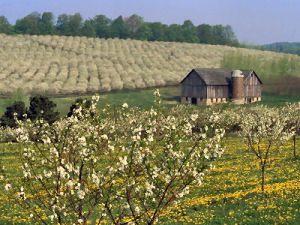
Cherry Orchard, Leelanau County
The Wolverine State
It has been generally accepted that Michigan was nicknamed "The Wolverine State" for the abundance of wolverines that once roamed the peninsula. However, according to the Michigan Historical Center, wolverines were very rare in Michigan if they were present at all. It's not clear how this nickname originated, but there are two theories.
Some think the nickname was originated by Ohioans in 1835 during a dispute over an Ohio/Michigan boundary called the "Toledo Strip." This dispute became known as the Toledo War. Though Michigan and Ohio both sent troops to the area, no shots were ever fired. It's said that Ohioans, at that time, referred to Michiganians as "...as vicious and bloodthirsty as wolverines."
Another theory is proposed that Native Americans compared the way that settlers were taking land, in the 1830s, to the way the excessively greedy wolverine went after its food.
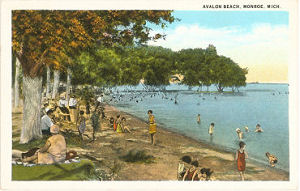
Avalon Beach, Monroe
The Great Lake State
or "The Great Lakes State", or "The Lakes State" nicknames have been applied to Michigan for many years. They refer to the fact that Michigan shores meet four of the five Great Lakes and to the number of inland lakes in the state. The four Great Lakes that border Michigan are Lake Superior, Lake Michigan, Lake Huron and Lake Erie. There are also more than 11,000 inland lakes in Michigan and, according to the Michigan Historical Center, one is never more than six miles from an inland lake or more than 85 miles from one of the Great Lakes.
From 1968 to 1975 and from 1979 to 1983, the legend on the standard Michigan License Plate read "The Great Lake State." This legend recognizes the Great Lakes and more than 11,000 inland lakes found in the state. This legend was changed to "Great Lakes" in 1984.
Water Wonderland
This promotional nickname again references the water resources of the state of Michigan. "Water Wonderland" appeared on Michigan license plates beginning in 1954. It was modified to "Water-Winter Wonderland" in 1965. This modified legend appeared on Michigan license plates from 1965 through 1967.
Lady of the Lake
With over 40,000 square miles of water surface within its boundaries, Michigan's history has been "saturated" with the association. "Lady of the Lake" is another nickname referencing the influence of water in the state. It is thought that this nickname may have been taken from Sir Walter Scott's poem, "The Lady of the Lake."
The Auto State
This nickname draws attention to the automobile manufacturing that has played such an important role in the history of the state.
THE STATE CITIZENS:
People who live in Michigan or who come from Michigan are called Michiganians, Michiganders or Michiganites.
THE STATE QUARTER:
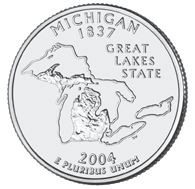
United States Mint Image
The Michigan quarter is the first of 2004, and the 26th in the United States Mint's 50 State Quarters® Program. On January 26, 1837, Michigan became the 26th state to be admitted into the Union. The Michigan quarter depicts the outline of the State and the Great Lakes system. The quarter is inscribed "Great Lakes State."
As indicated by the State's nickname, much of Michigan's history is tied to the Great Lakes - Superior, Michigan, Huron, Erie and Ontario. These are five of the world's largest lakes that, together, encompass more than 38,000 square miles and form the largest body of fresh water in the world. Michigan is the only State that borders four of the five Great Lakes, more than any other state. Standing anywhere in the State, a person is within 85 miles of one of the Great Lakes. To assist in navigating, Michigan has 116 lighthouses and navigational lights.
On November 28, 2001, Governor John Engler established the 25-member Michigan Quarter Commission. The Commission members consisted of individuals from the fields of education, art, history, and numismatics. The Commission solicited recommendations for design concepts from the residents of the State and received over 4,300 suggestions. The Commission narrowed the entries down to five candidate concepts that were approved by Governor Engler, and forwarded them to the United States Mint on May 10, 2002. Other design concepts considered included "Michigan State Outline, with Great Lakes and State Icons," "Michigan State Outline, with Great Lakes and the Mackinac Bridge," "Michigan State Outline, with the Mackinac Bridge and Automobile," and "Michigan State Outline, with Great Lakes and Automobile."
In September 2003, following a consultation with the Michigan Quarter Commission, Governor Jennifer Granholm selected the Great Lakes design.
For more about the state commemorative quarters, visit this page.
This 50 State Quarter Map is a great way to collect and display all 50 State Quarters.
Sources...
The State of Michigan: Department of Military and Veterans Affairs, History of the National Guard. 4 October 2009
The State of Michigan: The Michigan Historical Center, Michigan History. 24 October 2002
Shankle, George Earlie. State Names, Flags, Seals, Songs, Birds, Flowers, and Other Symbols. Irvine, Calif.: Reprint Services Corp, Revised edition, 1971.
Shearer, Benjamin F. and Barbara S. State Names, Seals, Flags and Symbols: A Historical Guide Third Edition, Revised and Expanded. Westport, Conn: Greenwood Press, 3 Sub edition, 2001.
Additional Information
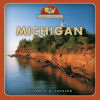
Michigan
Elizabeth M. Johnson
Michigan (From Sea to Shining Sea), Elizabeth M. Johnson. 80 pages. Publisher: Children's Press(CT) (March 2002) Reading level: Grades 3-5. Presents information about Michigan's people, geography, history, landmarks, natural resources, government, state capitol, towns and cities, and more.
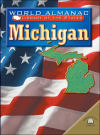
Michigan
Rachel Barenblat
Michigan (World Almanac Library of the States), by Rachel Barenblat. 48 pages. Gareth Stevens Publishing (January 1, 2002) Reading level: Grades 4-6. Filled with the most up-to-date information, including the latest Census results. Full-color photos bring to life the story of Michigan. In addition to an in-depth factual profile of Michigan in the form of a state Almanac, this book offers fascinating and lively discussions of the state's history, people, geography, government, economy, culture, and lifestyles. A section on Notable People, a calendar of events, and enough primary source documents, time lines, maps, and other tools to make this unquestionably the best young adult reference material on the USA available anywhere.
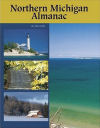
Northern Michigan
Almanac
Ronald Jolly
Northern Michigan Almanac, by Ronald Jolly. 606 pages. Publisher: University of Michigan Press/Petoskey (July 8, 2005) The almanac centers around Traverse City and includes areas around Petoskey, Frankfort, Charlevoix, Ludington, and the major islands in Lakes Huron and Michigan. Author Ron Jolly brings interesting, little-known facts about geography, weather, tourism, agriculture, ecology, business, transportation, government, and more to light-for example, which movies were made in the region, where the ghost towns are, and why fruit in Michigan is such a big business.
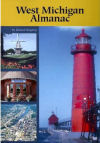
West Michigan
Almanac
Edward Hoogterp
West Michigan Almanac, by Edward Hoogterp. 488 pages. Publisher: University of Michigan Press/Petoskey (October 23, 2006) Edward Hoogterp is a journalist with more than thirty year experience as a writer and editor at Michigan newspapers. Until his retirement from Booth Newspapers, Hoogterp was a state capitol correspondent. His coverage focused on the environment and such topics as agriculture, transportation, land use, and tourism. He lives in Beulah, Michigan.
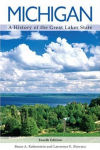
Michigan
Bruce A. Rubenstein
Lawrence E. Ziewacz
Michigan: A History of the Great Lakes State, by Bruce A. Rubenstein and Lawrence E. Ziewacz. 360 pages. Publisher: Harlan Davidson; 4 edition (April 30, 2008) Like all states, Michigan has grown because of the boldness, wisdom, strength, and creativity of its citizens. In the Third Edition of their popular text, Professors Rubenstein and Ziewacz have combined to present a different kind of state history, one that includes the traditional accounts - the impact of the French and British, the rise of the automobile industry, and the tales of lumbering and mining - but one that also portrays an unflinching account of the story of all the peoples of Michigan, with special emphasis given to American Indians, women's suffrage, and the contributions of white ethnics. Informed by the latest research and taking the Michigan saga right up to the present, this beautiful, well-illustrated book is certain to inform students and all those interested in the unique history of the Great Lakes State.
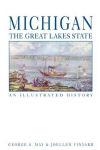
Michigan
the Great Lakes State
George S. May
Joellen Vinyard
Michigan, the Great Lakes State: An Illustrated History , by George S. May, Joellen Vinyard. 99 pages. Publisher: American Historical Press (October 15, 2005) Reading level: Young Adult. Michigan's rich history comes alive in this engaging tribute to the state. From early explorers, fur traders and farmers, to machinery, motors and manufacturing, and, ultimately automobiles that made Michigan famous this is a compelling account of the Great Lakes State.
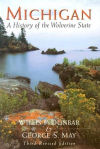
Michigan
Willis F. Dunbar
George S. May
Michigan: A History of the Wolverine State, by Willis F. Dunbar, George S. May. 769 pages. Publisher: Wm. B. Eerdmans Publishing Company; 3 Rev Sub edition (July 1995) This standard textbook on Michigan history covers the entire scope of the Wolverine State's historical record. This third revised edition incorporates events since 1980 and draws on new studies to expand and improve its coverage of various ethnic groups, recent political developments, labor and business, and many other topics.



